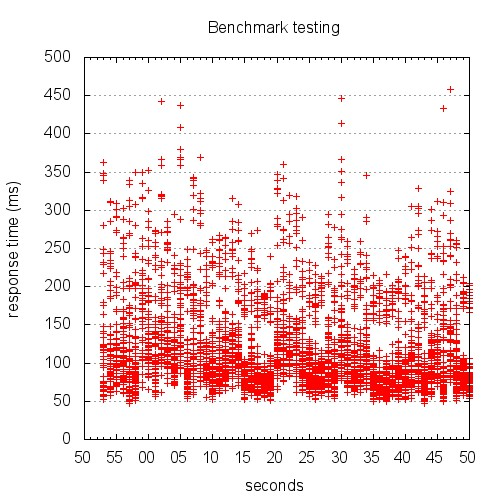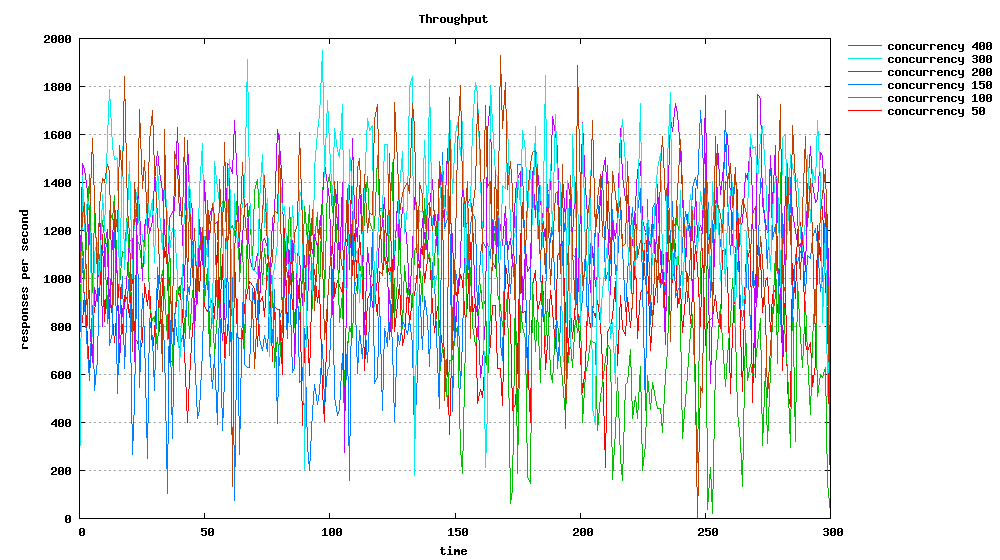Apache Beach (ab)是Apache自带的一个性能测试工具,专门用来测试网站的性能, 不仅限于Apache web服务器。
它可以同时模拟多个并发请求,测试Web服务器的最大承载压力,同时也可以根据Apache Bench提供的测试结果对服务器性能参数进行调整。它可以记录测试数据,其它工具比如Gnuplot可以利用测试数据进行分析。它也可以提供一个summary,可以直观显示当前测试的web服务器的性能。
安装ab
ab是Apache httpd的一部分。不同的发行版提供了不同的安装方法。
比如在笔者使用的redhat 6.4上可以查看此工具在哪个包里:
1 | #yum provides /usr/bin/ab |
它被打包在httpd-tools包里,安装httpd-tools:
1 | yum install httpd-tools |
安装成功后查看帮助:
1 | ab -h |
或
1 | man ab |
运行ab
一个最简单的ab例子就是:
1 | # ab -n 100 -c 10 http://www.google.com/ |
注意网址后面要加”/“或者明确的path如”https://www.google.com/?gfe_rd=cr&ei=_BvfU77ZGMeL8QfugIHAAw".
“-c”是并发数,可以模拟同时有多少个clients并发访问。
“-n”表示总的请求数。每个client发送的请求数为此数字除以client数(上面的数字)。
“-t”可以指定测试的最大时间,如果还不到此数请求已经发完,那么测试也会结束。当使用-t参数时,ab内部默认最大的请求数为50000,为了同时使用”-n”指定的参数,可以将”-t”参数放在”-n”参数之前, 如果想了解更多的信息, 可以查看这篇文章.
实际运行ab
我使用apache ab要测试的是一个tomcat搭建的集群,上面跑着CPU密集型的一个应用程序,前面使用nginx作为load balancer。
此应用的一个主要的服务通过RESTful service提供, 并且是POST类型的。 Request body是一个XML。
我想随机的替换body中的一个属性,以便测试动态请求对服务器的影响。 但是Apache ab只能提供静态的数据,所以我下载了它的代码并改造了一下。
首先创建了一个request.xml, 并将其中的那个属性改为占位符 修改ab.c文件,将发送请求中的占位符用随机数代替
修改的代码可重用性不高,在这里就不贴了。
写了一个脚本,可以测试不同的并发数:
1 | for var in {4,20,50,100,150,200,300} |
使用Gnuplot生成图表
在上一步中生成了测试数据,我们可以通过Gnuplot这一强大的工具生成漂亮的图表了。
在生成图表之前,我们还需要处理一下获得的数据,
如果直接使用测试生成报表,我们可能得到这样一个图表:

相应的Gnuplot文件为:
1 | #output as png image |
这张图有参考价值,我们可以看到大部分的请求的相应时间落在那个数值段中,但是不能以时间序列显示服务器的性能。 它是以”总用时“ (ttime) 进行排序,所以一般它会一条上升的曲线来显示。
这篇文章中指出了一种按照时间序列显示数据的方法。 Apapche ab生成的测试数据中已经包含了时间戳,可以修改Gnuplot生成按时间序列显示的响应时间图:
[
Gnuplot文件为:
1 | # Let's output to a jpeg file |
为了得到按时间序列显示的吞吐率图表,我们可以处理一下得到的测试数据:
1 | for var in {4,20,50,100,150,200,300} |
然后根据一下的Gnuplot配置生成图表。
1 | #output as png image |
